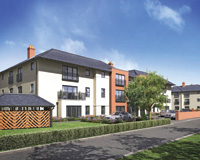Is Birmingham’s residential development market recovering or still bogged down by oversupply and a mismatch of stock type to buyer? It depends where you look, and whether you are talking sale or rental.
“Mortgage austerity and low loan-to-value ratios from most mainstream lenders have led to all city centre sites with planning being mothballed,” says Savills’ residential development director in Birmingham, Simon Horan.
This feeling of a city centre new-build desert is exacerbated by the unrealistic prices of stock built and bought in the boom, some of it now having been on sale for years by investors who cannot afford to sell below their borrowing levels. “Many of these are overpriced,” says Akbar Sheikh of Locksbridge Developments, a Birmingham residential and mixed-use developer. “They were originally bought at peak and sellers are unwilling to recognise we are now operating in a different market.”
But development activity in Britain’s second city should not be judged solely by its city centre standstill. Two other markets – new-build in the suburbs and the general private rented sector – are much livelier.
In the city’s more affluent suburbs, the funding of developments has eased significantly. So in Harborne, Edgbaston, Moseley, Sutton Coldfield and Solihull, “finance is no longer an issue for housebuilders”, says Savills associate Emma Warom. “We are seeing unconditional offers come through regularly, which hasn’t been witnessed since 2007.”
An indication of this confidence in the suburbs is Taylor Wimpey’s Highfield Gardens on the Calthorpe Estate, Edgbaston – touted by the developers as “the Midlands’ equivalent of Kensington” – where six houses and 51 apartments will be built. This is a rare example of an apartment-led scheme securing funding in Birmingham. Savills, which advised, says its success was down to its location, where apartments secure close to £300 per sq ft – almost on a par with houses.
That scheme apart, most other developments in the suburbs are house-led. “Appetite currently exists only for ‘family houses’, defined as detached or semi-detached with a garden in a high-quality residential location where professional diligence confirms strong demand for the product,” says Iain McArthur, associate director of DTZ’s Birmingham residential team.
The suburbs received a further boost this month with consent for a joint St Modwen/Persimmon Homes scheme to build 725 homes, almost all two- to four-bed houses, on the 52-acre former Longbridge East plant at Cofton Hackett.
The first phase will produce 229 houses with the emphasis on all ages as owner occupiers, rather than the young professional and investor target groups for city centre schemes.
“The Longbridge Area Action Plan identified the site primarily for new housing,” says Richard Hickman, planning manager for St Modwen, which has pumped £85m into regeneration projects in the area since 2003. “We have now allowed for the provision of a wider range of accommodation for the elderly in the later phases of the development.”
But these signs of positive growth in Birmingham’s suburbs are nothing compared with the stellar growth seen in the private rented sector across almost all of the city. There are two reasons for this. First, many would-be first-time buyers are unable to secure a mortgage or save enough for a deposit and have to rent, and second, the city’s expanding student population has hit 65,000, making it the UK’s largest after London.
“Supply at times has been so short that entire days have been filled with back-to-back viewings,” says Ben Evans of Fleet Milne Residential, a letting agency that collected £7m in rents in Birmingham last year. Evans says this huge demand has helped soak up most of the oversupply of unsellable city centre apartments, with some landlords securing rents up to 20% above the asking price.
Even so, this demand is not enough to bring some city centre schemes out of mothballs, but investors and agents of existing units have seen returns soar, with rents rising 40% in the past four years.
But student numbers have started to plateau at some of the city’s five leading academic institutions, and a DTZ survey shows that, after 10 years of expansion, the stock of purpose-built accommodation “now meets the demand from city centre universities, and we would be surprised to see further student-specific development”, says DTZ’s McArthur.
Plans for a 23-storey tower of 826 student rooms, transforming the site of Birmingham’s former central fire station, were rejected by councillors recently, but developer Watkins Jones says it will work with planners to reshape the plans into an acceptable form.
So there is recovery in residential development, but only in some sectors and only up to a point. Fragility is the watchword – yet, after years of downturn, Birmingham may just settle for fragility.
Whither development under Labour?
Labour is in single-party control of Birmingham council for the first time since 2003, and leader Sir Albert Bore has taken personal responsibility for housing and regeneration.
The council has announced plans to devolve its 65,000 homes to 10 local areas, one in each city constituency, and has shelved funding for the regeneration of Stirchley Baths pending a reassessment of the project, but otherwise remains tight-lipped about its plans.
The centrepiece of existing residential proposals is the Big City Plan, which was adopted in 2011 and includes a commitment to 5,000 homes in the core city centre.
Last month, Estates Gazette exclusively revealed that LandProp, the property and development arm of IKEA, is in talks with the council, British Waterways and the Homes and Communities Agency about unlocking the 52-acre Icknield Port development project .
Plans for the £900m development include more than 11,000 homes and 75,000 sq ft of commercial space. Bore is understood to be keen to see development on the site, which is located in his ward of Ladywood.











